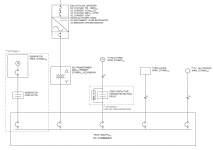Inverter is a Delta PCS 125 with Blue Ion 128 kWh LXHV. Support at Blue Ion recommended either adding a zig zag transformer to the delta side or an isolation resistance based GF relay on the delta side wired to a contactor that opens the wye side of the transformer when a GF condition is sensed.
Thanks, not sure I completely follow what you're saying yet... This is the diagram I was provided by the battery & inverter supplier showing the battery inverter connected to the delta side and the grid/loads on the wye side of the xfmr. ....
There appears to be some possibly conflicting, or at least confusing information here. As Jon mentioned, Delta Electronics includes the following instructions for the PCS125:
"If a transformer is required to be added between PCS and load, D type of transformer must be on PCS side."
Assuming this means delta transformer windings should be connected to the PCS125, the following from Jon is a reasonable justification for this requirement:
I assume that the battery system or inverter is providing the necessary protection for that part of the system, and that the isolation transformer is most appropriate. What you really don't want to do is connect a non-isolated neutral forming transformer to a system that already has its own grounding.
But if such isolation is needed, the recommendation by Blue Ion to add a zig-zag grounding transformer on the delta side would make no sense. I think consulting Delta Electronics directly about connecting their inverter could be wise.

If as Jon mentioned the battery/inverter system already provides sufficient protection, then the one-line looks good as long as the neutral from the generator and grid are disconnected when not providing power. That's because the delta-wye will be acting as a grounding transformer on the AC combiner bus.
By the way, Delta Electronics has a version PCS125HV that supplies 4-wire loads without a transformer. However, perhaps you will need a delta-wye anyway to act as a grounding transformer for the PV inverter output when in off grid mode. The PV connection in the 1-line says 4-wire, but it's likely the neutral is just used as a voltage reference.



